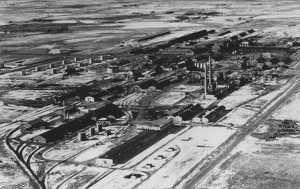
The South Plants area of Rocky Mountain Arsenal (RMA) was a complete chemical manufacturing complex designed, built and used by the U.S. Army.
During the late 1930s, the United States and other countries were keeping a sharp eye on Germany and its growing military might. Yet, the United States was intent on remaining neutral as was its intention in 1914. This time, though, the US did not want to be caught off guard. Plans for regional airfields that could be converted into pilot training centers soon became realities. One such airfield was located just south of Greenville. We know it today as Majors Field.
Pilot training was one of many needs facing a nation preparing for war while hoping and praying to avoid the crisis. American leaders along with colleagues in Europe vividly recalled the deadly chemical warfare introduced by Germany in the First World War. There was no doubt the same strategy would be used again. So plans were made for chemical warfare production. No tangible work began until after Pearl Harbor, but the ideas were in place.
Sites were chosen around the country, all away from coastal areas to prevent likely attacks. Each should be near a major transportation hub with both air and rail services available. A sufficient and reliable labor force must be nearby. Weather had to be suitable for year-round outdoor work and the soil must be appropriate.
The U. S. Army constructed the Rocky Mountain Arsenal on 17,000 acres of farm land just ten miles northeast of Denver in early 1942. Such deadly chemicals as white phosphorus, mustard gas, and napalm were manufactured there. At the peak of operations, 3,000 civilians mostly women worked at the Arsenal.
At the end of the war, private sectors of industry were encouraged to lease these various facilities. At the Arsenal Shell Oil Company began to produce agricultural pesticides. The Arsenal was reopened during the Korean Conflict and used throughout the Cold War era for its original purpose. Later the Arsenal manufactured rocket fuel used to power Apollo 11 flights.
Similar plans were made for Majors Field at the end of World War II. The site reverted back to the City of Greenville. Local companies leased parts of the site, until Temco began refurbishing aircraft and needed the entire field in 1951.
However, decades of chemical and agricultural production led to contamination of soil, structures, and groundwater at Rocky Mountain Arsenal. In 1982 all production there ceased, and the mission of the Arsenal changed from manufacturing to environmental cleanup and restoration.
Today Rocky Mountain Arsenal is part of the U. S. Fish and Wildlife Service that oversees the continued environmental cleanup. The Rocky Mountain Arsenal National Wildlife Refuge is working to restore the original short-grass prairie and provide habitat to more than 300 species of wildlife. A visit there recently allowed me to see prairie dogs for the first time ever. One of the little critters stood guard at the entrance to their vast underground residences and chirped to warn others of my approach. Other species seem to be acclimated to the homes their species enjoyed in the 19th century before so much upheaval.
Yet, the U. S. Army permanently retains and manages about 1,000 acres of land that contains landfills, waste consolidation areas and groundwater treatment facilities to ensure they remain protective of human health and the environment. Aren’t we glad Greenville was home to Majors Field?

